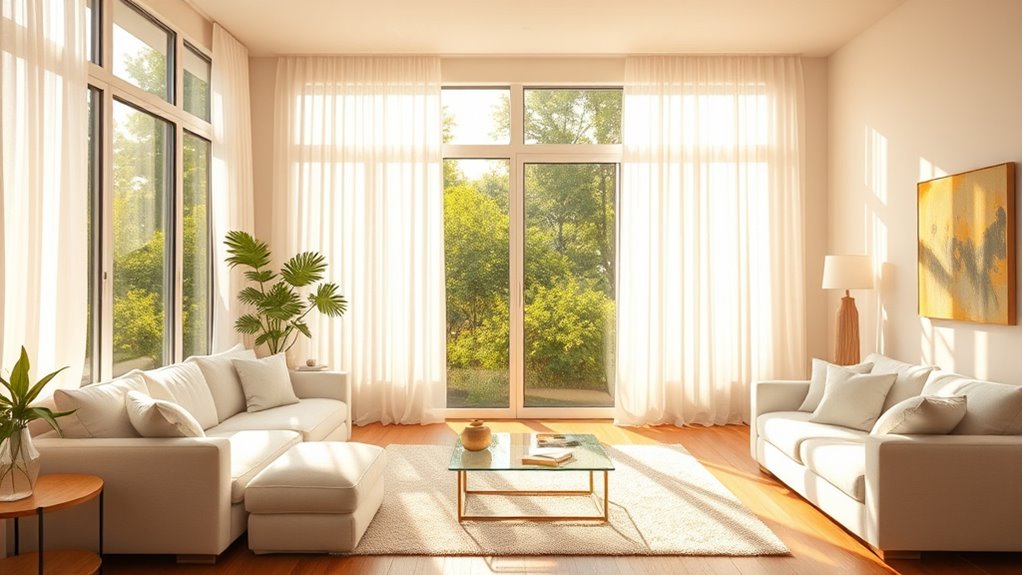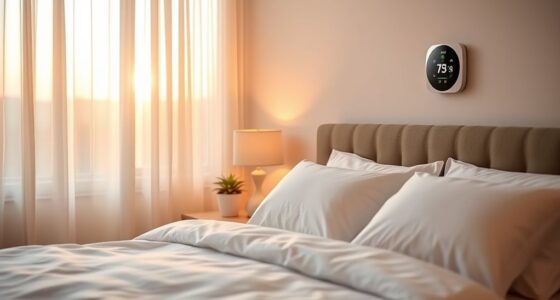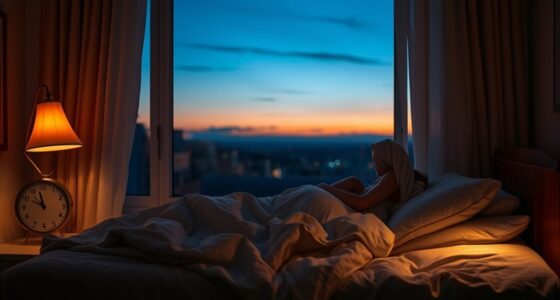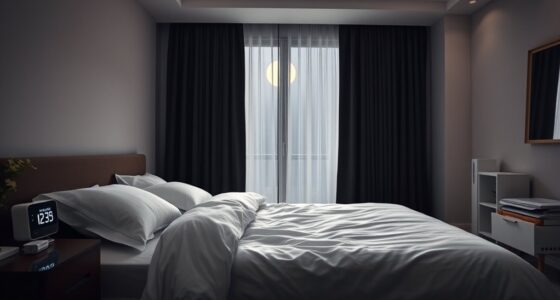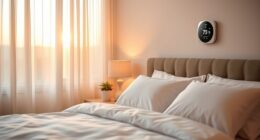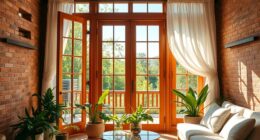To enhance your sleep quality, focus on increasing your daytime light exposure. Spend at least 20-30 minutes outdoors in natural sunlight, especially in the morning, to regulate your circadian rhythm and boost vitamin D production. Keep your indoor spaces bright by opening curtains and sitting near windows or using bright lights that mimic daylight. Consistent light exposure helps improve your mood, energy, and sleep patterns; explore more ways to optimize your lighting habits in your daily routine.
Key Takeaways
- Maximize natural light indoors by opening curtains and sitting near windows during daytime hours.
- Use bright interior lighting that mimics natural daylight to support circadian rhythm and alertness.
- Aim for at least 20-30 minutes of outdoor sunlight daily, preferably in the morning, to reinforce biological clocks.
- Consistent exposure to bright indoor environments improves mood, cognitive function, and sleep quality.
- Proper lighting during the day helps regulate melatonin production, leading to better sleep at night.
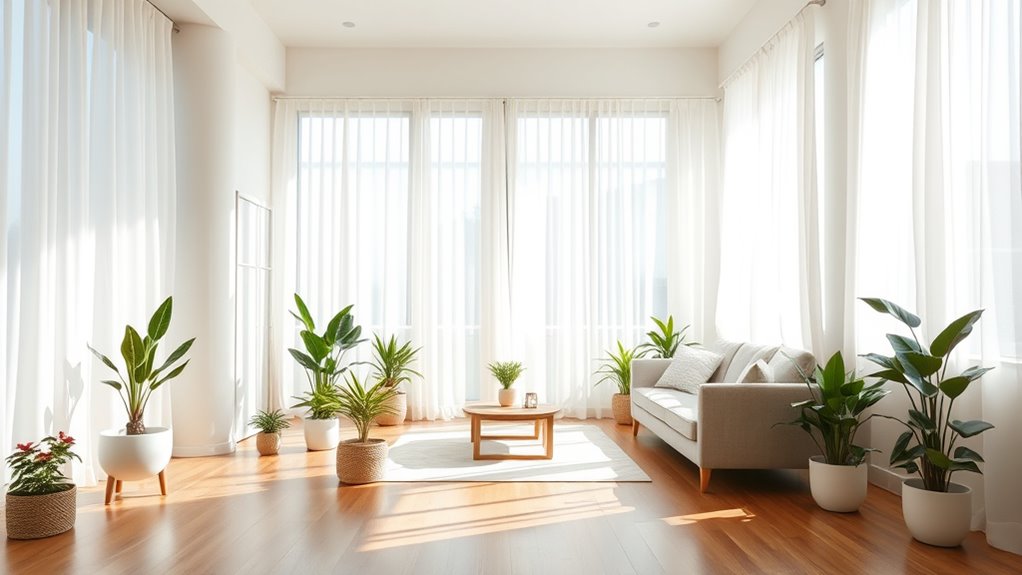
Exposure to natural light during the day plays a crucial role in regulating your body’s internal clock and maintaining overall well-being. When you get enough sunlight, your circadian rhythm regulation stays on track, helping you feel alert during the day and sleepy at night. This internal clock influences many physiological processes, including hormone production, body temperature, and sleep cycles. Without sufficient light exposure, your circadian rhythm can become disrupted, leading to difficulties falling asleep or feeling rested. Bright light during daylight hours signals your brain to stay awake and alert, setting the stage for better sleep quality when night falls.
Another key benefit of daytime light exposure is Vitamin D synthesis. When sunlight hits your skin, it triggers the production of this essential vitamin, which supports immune function, bone health, and mood regulation. Adequate Vitamin D levels can be challenging to maintain through diet alone, especially in winter months or for those with limited outdoor access. By spending time in natural light, you ensure your body produces enough Vitamin D naturally, reducing risks associated with deficiency, such as osteoporosis, depression, and weakened immunity.
To maximize these benefits, aim to spend at least 20 to 30 minutes outside each day, especially during the morning hours. Morning sunlight is particularly effective because it helps reinforce your circadian rhythm regulation, aligning your internal clock with the external environment. If outdoor exposure isn’t possible, consider investing in bright interior lighting that mimics natural daylight. Having well-lit spaces during the day keeps your body attuned to natural cycles, which can improve your sleep patterns and overall energy levels.
You should also be mindful of your indoor lighting habits. During the day, keep curtains open and sit near windows to soak up as much natural light as possible. Use adjustable lighting fixtures that can be brightened when natural light isn’t sufficient. Avoid dim or overly warm artificial lighting during daytime hours, as this can send mixed signals to your body about whether it’s daytime or evening, confusing your circadian rhythm. Additionally, lighting quality can influence how well your internal clock functions, emphasizing the importance of proper illumination.
Incorporating ample light exposure into your daily routine doesn’t just support sleep; it also enhances your mood, cognitive function, and physical health. By regulating your circadian rhythm and ensuring adequate Vitamin D synthesis, you set the foundation for a healthier, more balanced life. So, make a conscious effort to embrace natural light whenever you can—your body will thank you.
Frequently Asked Questions
How Does Natural Light Exposure Affect Mental Health?
Natural light exposure positively impacts your mental health by regulating your circadian rhythm, helping you feel alert during the day and sleepy at night. When you get enough sunlight, your mood regulation improves, reducing risks of depression and anxiety. Bright interiors mimic natural light, boosting your overall well-being. So, spending time outside or enhancing indoor lighting can make a meaningful difference in maintaining mental stability and emotional balance.
Can Artificial Bright Lighting Mimic the Effects of Sunlight?
Think of artificial bright lighting as a candle in a vast room—it can mimic sunlight but isn’t quite the same. While high light intensity and a color temperature around 5000-6500K can help replicate sunlight’s energizing effects, it doesn’t fully replace natural light‘s dynamic spectrum. You may feel more alert, but for ideal mental and sleep health, natural light remains unmatched in providing the complex, full-spectrum benefits your body craves.
What Are the Best Interior Design Tips for Maximizing Daylight?
To maximize daylight, position windows strategically to let in the most light, especially on the south and east sides. Choose light, reflective color schemes like whites and pastels to bounce natural light around your space. Keep window treatments minimal or sheer to allow sunlight to flow freely. Incorporate mirrors and open layouts to amplify brightness, creating a lively, well-lit environment that boosts your mood and sleep quality.
How Does Evening Light Exposure Impact Sleep Quality?
Evening light exposure can negatively impact your sleep quality by disrupting your circadian rhythm. Bright lights, especially blue wavelengths, suppress melatonin production, making it harder to fall asleep and reducing sleep quality. To improve your sleep, dim your lights an hour before bedtime and avoid screens. This allows your melatonin levels to rise naturally, helping you fall asleep faster and enjoy more restorative rest.
Are There Specific Light Wavelengths That Improve Sleep?
Ever wondered if certain light wavelengths can boost your sleep? Blue light, in particular, influences your circadian rhythms, so limiting it in the evening helps you sleep better. During the day, exposure to blue light can keep you alert, but at night, reducing it promotes melatonin production. Using warm, dim lighting in the evening supports your natural sleep cycle, ensuring you wake up refreshed.
Conclusion
By embracing brighter interiors during the day, you invite better sleep at night. The contrast between vibrant mornings and restful evenings creates a natural rhythm, guiding your body toward balance. Don’t underestimate the power of light—it’s both a energizer and a sleep facilitator. When you prioritize daytime brightness, you set the stage for deeper, more restorative sleep. Brighten your days, and watch your nights transform into peaceful, rejuvenating rest.
